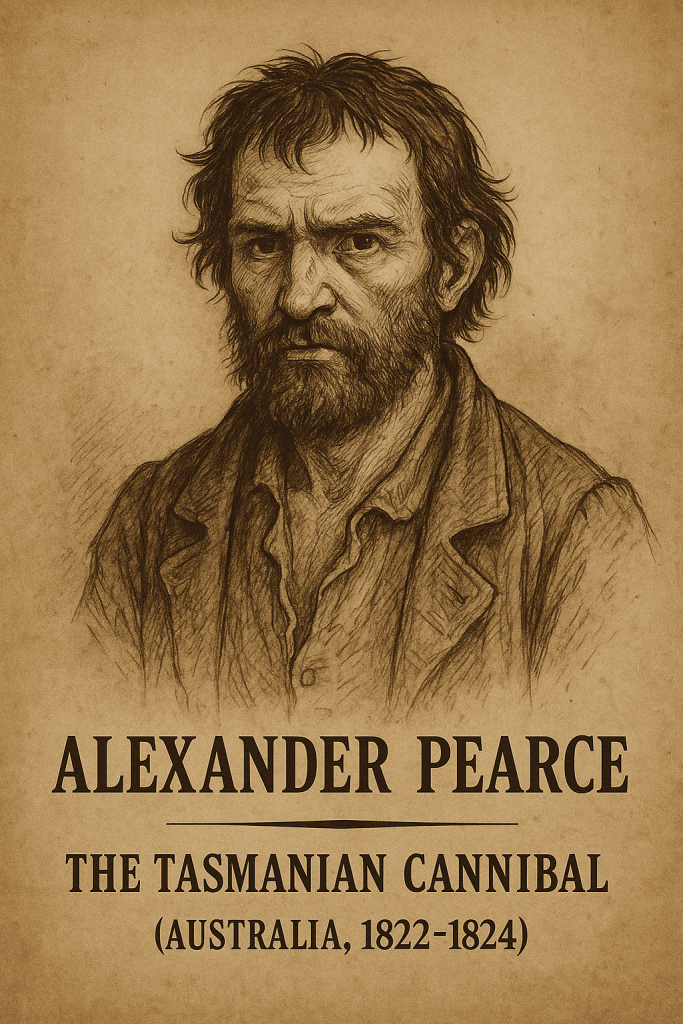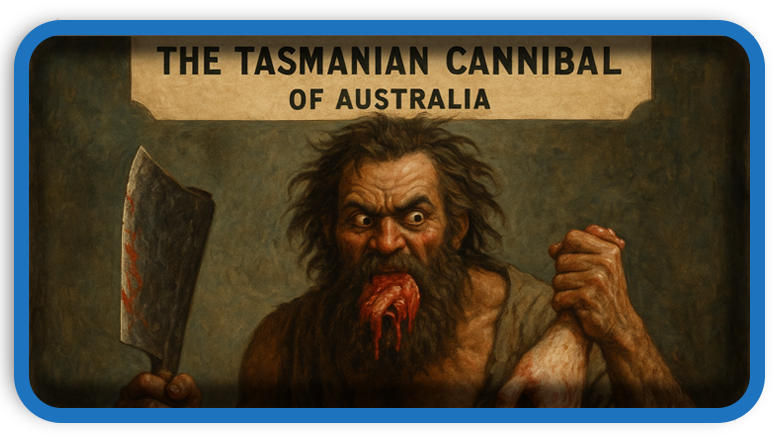⏲️ Estimated reading time: 5 min
Alexander Pearce shocked colonial Australia with a gruesome tale of murder and cannibalism. Between 1822 and 1824, his escape from a Tasmanian penal colony led to one of the darkest survival stories in Australian history.
Alexander Pearce – The Tasmanian Cannibal (Australia, 1822–1824)
Who Was Alexander Pearce?
In the brutal penal colonies of early 19th-century Australia, one name haunts the archives more than most Alexander Pearce, an Irish convict turned cannibal. Born in County Monaghan, Ireland, around 1790, Pearce was transported to the Australian penal system in 1819 for theft. But his true infamy would unfold not in the Irish countryside, but in the rugged wilderness of Tasmania (then called Van Diemen’s Land).
Pearce’s story is not just one of escape from prison, but of desperation, betrayal, and unimaginable acts of survival. His tale still echoes through the mountains and forests of Tasmania.
Life in Van Diemen’s Land
The British Empire established penal settlements in Tasmania to house the worst repeat offenders from the mainland colonies. Macquarie Harbour Penal Station was one such place, considered hell on Earth. Cut off from civilization by treacherous waters and thick forests, escape seemed impossible. But for men like Pearce, risking death was better than enduring the torment of forced labor, starvation, and abuse.
In 1822, Pearce and seven other convicts fled Macquarie Harbour into the unknown wilderness. With no food and little hope, they faced the unforgiving Tasmanian landscape with nothing but their desperation.
The First Escape – Descent Into Cannibalism
The escapees Robert Greenhill, Matthew Travers, Alexander Pearce, and others quickly realized they were woefully unprepared. Starvation set in within days. Wildlife was scarce, and the terrain impassable. One by one, members of the group began to die not from exposure, but from murder.
It began when Greenhill and Travers killed one of the weaker members, slicing him up to eat. Pearce, horrified yet starving, soon joined in. What started as a survival tactic evolved into a cycle of murder and cannibalism. Pearce later described the process with chilling detachment. Men were killed and eaten as needed until only Pearce remained.
He was captured several weeks later, alone and emaciated. When he confessed to cannibalism, authorities didn’t believe him. They assumed he was covering for his fellow escapees. But the bodies and missing convicts were never found.

Returned to Macquarie Harbour – and Escaped Again
Instead of executing Pearce, the British returned him to the hell of Macquarie Harbour, assuming he had fabricated the entire tale.
But in 1823, Pearce escaped again, this time with a fellow convict named Thomas Cox. Within 11 days, Pearce was caught alone once more, with Cox nowhere in sight. On him was part of a human liver.
This time, his guilt could not be ignored. Pearce admitted to killing and eating Cox. He told the authorities something chilling:
“It’s better to eat a man than to be eaten by him.”
The Trial and Execution
Pearce’s second confession was so detailed and grotesque that it shocked the colony. Authorities could no longer deny the truth: Alexander Pearce was a cannibal, not once, but twice. He had deliberately murdered his companion for food after escaping a penal station known for starvation and brutality.
He was tried in Hobart and found guilty of murder. On July 19, 1824, Pearce was hanged. In his final moments, he reportedly asked the priest if human flesh was truly a sin to eat.
The hangman is said to have been so disgusted by Pearce’s crimes that he refused to shake his hand before execution.
Legacy and Impact
The story of Alexander Pearce has since entered Australian folklore as a symbol of the horrors endured in the colonial penal system. But it also represents the terrifying edge of human desperation.
Pearce wasn’t a cold-blooded killer by modern definitions. He was a desperate man in a desperate time, pushed to the brink by starvation and isolation. Still, the gruesomeness of his actions has led many to label him Australia’s first serial killer and a true-life monster.
Over the years, his story has inspired books, plays, films, and even songs. The Tasmanian wilderness, once a landscape of hope for escape, became stained with the memory of one man’s descent into madness and cannibalism.
Was Pearce Evil or a Product of His Environment?
This question continues to divide historians and psychologists. On one hand, Pearce showed no remorse and participated willingly in cannibalism more than once. On the other, he lived in one of the most brutal environments imaginable where torture, starvation, and abandonment were routine.
Pearce may not have started as a murderer, but his actions driven by fear and survival transformed him into one. He never sought redemption. He never denied the horror. In many ways, his final honesty is what kept his story alive for over two centuries.
Final Thoughts
Alexander Pearce remains a haunting reminder of how fragile the line is between civilization and savagery. His tale is not just about murder or cannibalism it’s about what happens when society fails the people it punishes. And it’s a tale that continues to fascinate, horrify, and provoke debate.
🔔 For more tutorials like this, consider subscribing to our blog.
📩 Do you have questions or suggestions? Leave a comment or contact us!
🏷️ Tags: Alexander Pearce, Tasmanian history, Australian crime, Macquarie Harbour, cannibalism, colonial Australia, penal colony, true crime, convict stories, historical crime
📢 Hashtags: #AlexanderPearce, #TrueCrime, #Tasmania, #AustralianHistory, #Cannibalism, #ConvictEscape, #MacquarieHarbour, #HistoricCrimes, #SurvivalStory, #HorrorHistory
The Dark Reckoning
Pearce’s final words were not of sorrow, but of grim acknowledgment. He had walked through hell, and in the end, became the very monster he feared. Whether driven by madness or primal instinct, the Tasmanian Cannibal carved his place in the annals of Australia’s darkest legends.
Only logged-in users can submit reports.
Discover more from HelpZone
Subscribe to get the latest posts sent to your email.

